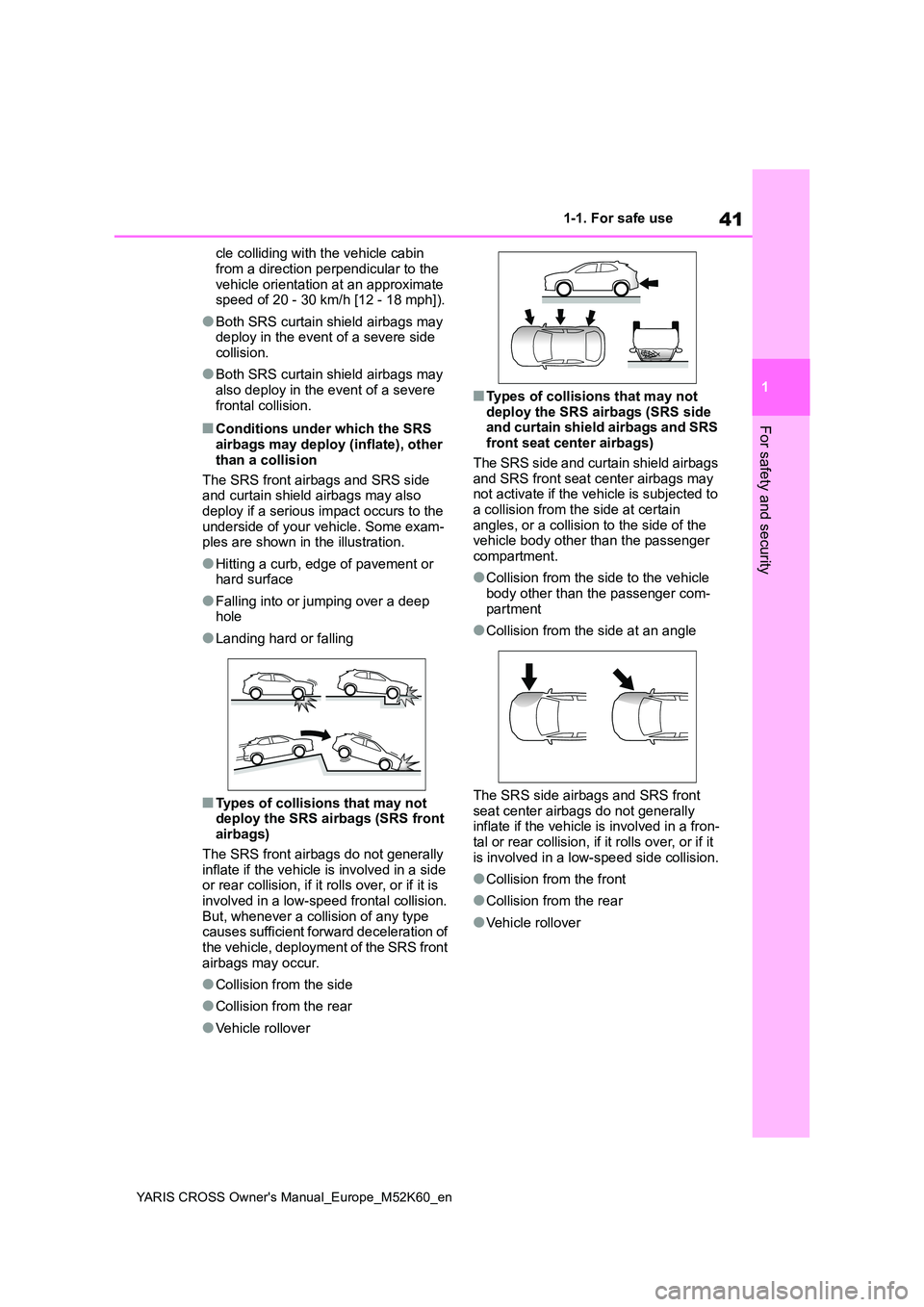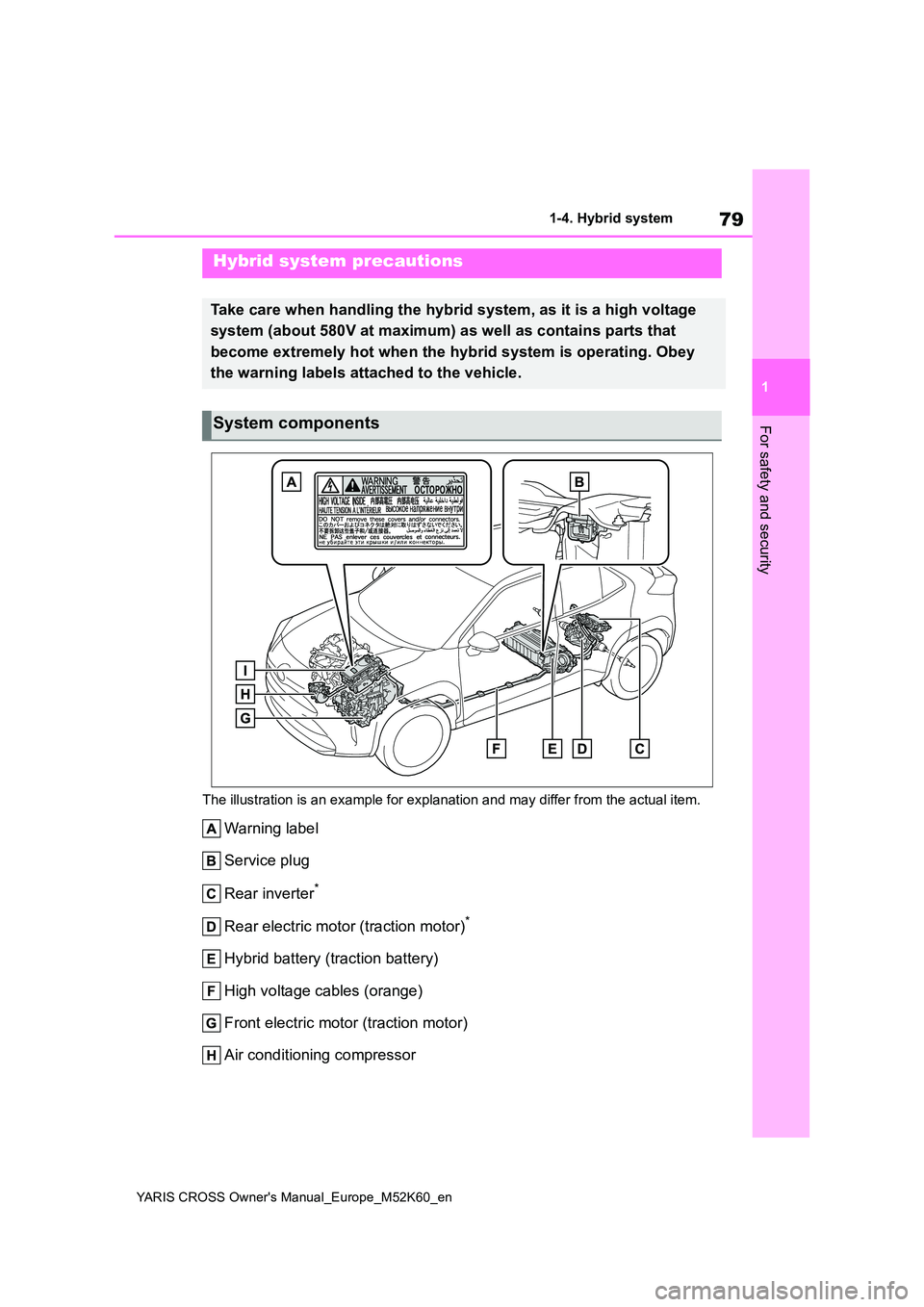2021 TOYOTA YARIS CROSS air condition
[x] Cancel search: air conditionPage 3 of 650

1
6
5
4
3
2
7
8
YARIS CROSS Owner's Manual_Europe_M52K60_en
Pictorial indexSearch by illustration
For safety
and security
Make sure to read through them
(Main topics: Child seat, theft deterrent system)
Vehicle status
information and
indicators
Reading driving-related information
(Main topics: Meters, multi-information display)
Before driving
Opening and closing the doors and windows, adjustment
before driving
(Main topics: Keys, doors, seats, power windows)
DrivingOperations and advice which are necessary for driving
(Main topics: Starting hybrid system, refueling)
Interior featuresUsage of the interior features
(Main topics: Air conditioner, storage features)
Maintenance
and care
Caring for your vehicle and maintenance procedures
(Main topics: Interior and exterior, light bulbs)
When trouble
arises
What to do in case of malfunction and emergency
(Main topics: 12-volt battery discharge, flat tire)
Vehicle
specifications
Vehicle specifications, customizable features
(Main topics: Fuel, oil, tire inflation pressure)
IndexSearch by symptom
Search alphabetically
Page 6 of 650

4
YARIS CROSS Owner's Manual_Europe_M52K60_en
TABLE OF CONTENTS
5-1. Using the air conditioning
system and defogger
Automatic air conditioning sys-
tem .................................... 350
Heated steering wheel/seat
heaters.............................. 356
5-2. Using the interior lights
Interior lights list .................. 358
5-3. Using the storage features
List of storage features ....... 360
Luggage compartment features
.......................................... 363
5-4. Other interior features
Other interior features ......... 367
6-1. Maintenance and care
Cleaning and protecting the
vehicle exterior ................. 376
Cleaning and protecting the
vehicle interior .................. 379
6-2. Maintenance
Maintenance requirements . 382
6-3. Do-it-yourself maintenance
Do-it-yourself service precau-
tions .................................. 384
Hood ................................... 386
Positioning a floor jack ........ 387
Engine compartment........... 389
12-volt battery ..................... 394
Tires .................................... 396
Tire inflation pressure ......... 406
Wheels ................................ 408
Air conditioning filter ........... 410
Cleaning the hybrid battery (trac-
tion battery) air intake vent and
filter ................................... 412
Wireless remote control/elec-
tronic key battery .............. 415
Checking and replacing fuses
.......................................... 418
Light bulbs .......................... 423
7-1. Essential information
Emergency flashers ............ 430
If your vehicle has to be stopped
in an emergency ............... 430
If the vehicle is submerged or
water on the road is rising 431
5Interior features
6Maintenance and care
7When trouble arises
Page 18 of 650

16
YARIS CROSS Owner's Manual_Europe_M52K60_en
Pictorial index
Multi-information display ...................................... ................ P.106, 112
Display ........................................................ ............................. P.106, 112
Energy monitor................................................. ................................P.123
When a warning message is displayed............................ ................P.449
Turn signal lever .............................................. ..............................P.200
Headlight switch ............................................... .............................P.206
Headlights/front position lights/tail lights/daytime running li ghts ......P.206
Front fog lights*3/rear fog light ................................................ .........P.218
Windshield wiper and washer switch ............................. .............P.219
Rear window wiper and washer switch ............................ ...........P.222
Usage.......................................................... .............................P.219, 222
Adding washer fluid............................................ ..............................P.393
Emergency flasher switch....................................... ......................P.430
Hood lock release lever ........................................ .........................P.386
Tilt and telescopic steering lock release lever................ ............P.164
Air conditioning system ........................................ ........................P.350
Usage.......................................................... .....................................P.350
Rear window defogger ........................................... ..........................P.352
Multimedia system (7-inch/8-inch display model)*3, 4
Multimedia system (9-inch display model)*3, 5
Fuel filler door opener ........................................ ...........................P.225
*1: Vehicles without a smart entry & start system
*2: Vehicles with a smart entry & start system
*3: If equipped
*4: Refer to “Navigation and multimedia system Owner’s manual”.
*5: Refer to “TOYOTA SMART CONNECT Owner’s manual”.
Page 26 of 650

24
YARIS CROSS Owner's Manual_Europe_M52K60_en
Pictorial index
Multi-information display ...................................... ................ P.106, 112
Display ........................................................ ............................. P.106, 112
Energy monitor................................................. ................................P.123
When a warning message is displayed............................ ................P.449
Windshield wiper and washer switch ............................. .............P.219
Rear window wiper and washer switch ............................ ...........P.222
Usage.......................................................... .............................P.219, 222
Adding washer fluid............................................ ..............................P.393
Turn signal lever .............................................. ..............................P.200
Headlight switch ............................................... .............................P.206
Headlights/front position lights/tail lights/daytime running li ghts ......P.206
Front fog lights*3/rear fog light ................................................ .........P.218
Emergency flasher switch....................................... ......................P.430
Hood lock release lever ........................................ .........................P.386
Tilt and telescopic steering lock release lever................ ............P.164
Air conditioning system ........................................ ........................P.350
Usage.......................................................... .....................................P.350
Rear window defogger ........................................... ..........................P.352
Multimedia system (7-inch/8-inch display model)*3, 4
Multimedia system (9-inch display model)*3, 5
Fuel filler door opener ........................................ ...........................P.225
*1: Vehicles without a smart entry & start system
*2: Vehicles with a smart entry & start system
*3: If equipped
*4: Refer to “Navigation and multimedia system Owner’s manual”.
*5: Refer to “TOYOTA SMART CONNECT Owner’s manual”.
Page 42 of 650

40
YARIS CROSS Owner's Manual_Europe_M52K60_en
1-1. For safe use
“PASSENGER AIR BAG” indicator
Airbag sensor assembly
The main SRS airbag system components are shown above. The SRS air-
bag system is controlled by the airbag sensor assembly. As the airbags
deploy, a chemical reaction in the inflators quickly fills the airbags with non-
toxic gas to help restrain the motion of the occupants.
■If the SRS airbags deploy (inflate)
●Slight abrasions, burns, bruising etc., may be sustained from SRS airbags,
due to the extremely high speed deployment (inflation) by hot gases.
●A loud noise and white powder will be emitted.
●Parts of the airbag module (steering wheel hub, airbag cover and inflator) as well as the front seats, parts of the
front and rear pillars, and roof side rails, may be hot for several minutes.
The airbag itself may also be hot.
●The windshield may crack.
●The hybrid system will be stopped and fuel supply to the engine will be
stopped. ( P.82)
●The brakes and stop lights will be con-
trolled automatically. ( P.337)
●The interior lights will turn on automat-
ically. ( P.359)
●The emergency flashers will turn on
automatically. ( P.430)
●Vehicles with eCall: If any of the fol-
lowing situations occur, the system is
designed to send an emergency call* to the eCall control center, notifying
them of the vehicle’s location (without needing to push the “SOS” button) and an agent will attempt to speak
with the occupants to ascertain the level of emergency and assistance required. If the occupants are unable
to communicate, the agent automati- cally treats the call as an emergency and helps to dispatch the necessary
emergency services. ( P.65) • An SRS airbag is deployed.
• A seat belt pretensioner is activated. • The vehicle is involved in a severe rear-end collision.*: In some cases, the call cannot be
made. ( P. 6 6 )
■SRS airbag deployment conditions
(SRS front airbags)
●The SRS front airbags will deploy in
the event of an impact that exceeds the set threshold level (the level of force corresponding to an approxi-
mately 20 - 30 km/h [12 - 18 mph] frontal collision with a fixed wall that does not move or deform).
However, this threshold velocity will be
considerably higher in the following situ-
ations:
• If the vehicle strikes an object, such as a parked vehicle or sign pole, which can move or deform on impact
• If the vehicle is involved in an under- ride collision, such as a collision in which the front of the vehicle “under-
rides”, or goes under, the bed of a truck
●Depending on the type of collision, it is possible that only the seat belt pretensioners will activate.
■SRS airbag deployment conditions
(SRS side and curtain shield air- bags and SRS front seat center air-bags)
●The SRS side and curtain shield air-bags and SRS front seat center air-
bags will deploy in the event of an impact that exceeds the set threshold level (the level of force corresponding
to the impact force produced by an approximately 1500 kg [3300 lb.] vehi-
Page 43 of 650

41
1
YARIS CROSS Owner's Manual_Europe_M52K60_en
1-1. For safe use
For safety and security
cle colliding with the vehicle cabin
from a direction perpendicular to the vehicle orientation at an approximate speed of 20 - 30 km/h [12 - 18 mph]).
●Both SRS curtain shield airbags may deploy in the event of a severe side
collision.
●Both SRS curtain shield airbags may
also deploy in the event of a severe frontal collision.
■Conditions under which the SRS airbags may deploy (inflate), other
than a collision
The SRS front airbags and SRS side and curtain shield airbags may also
deploy if a serious impact occurs to the underside of your vehicle. Some exam-ples are shown in the illustration.
●Hitting a curb, edge of pavement or hard surface
●Falling into or jumping over a deep hole
●Landing hard or falling
■Types of collisions that may not deploy the SRS airbags (SRS front airbags)
The SRS front airbags do not generally inflate if the vehicle is involved in a side or rear collision, if it rolls over, or if it is
involved in a low-speed frontal collision. But, whenever a collision of any type causes sufficient forward deceleration of
the vehicle, deployment of the SRS front airbags may occur.
●Collision from the side
●Collision from the rear
●Vehicle rollover
■Types of collisions that may not
deploy the SRS airbags (SRS side and curtain shield airbags and SRS front seat center airbags)
The SRS side and curtain shield airbags and SRS front seat center airbags may not activate if the vehicle is subjected to
a collision from the side at certain angles, or a collision to the side of the vehicle body other than the passenger
compartment.
●Collision from the side to the vehicle
body other than the passenger com- partment
●Collision from the side at an angle
The SRS side airbags and SRS front
seat center airbags do not generally inflate if the vehicle is involved in a fron-tal or rear collision, if it rolls over, or if it
is involved in a low-speed side collision.
●Collision from the front
●Collision from the rear
●Vehicle rollover
Page 81 of 650

79
1
YARIS CROSS Owner's Manual_Europe_M52K60_en
1-4. Hybrid system
For safety and security
The illustration is an example for explanation and may differ from the actual item.
Warning label
Service plug
Rear inverter*
Rear electric motor (traction motor)*
Hybrid battery (traction battery)
High voltage cables (orange)
Front electric motor (traction motor)
Air conditioning compressor
Hybrid system precautions
Take care when handling the hybrid system, as it is a high volt age
system (about 580V at maximum) as well as contains parts that
become extremely hot when the hybrid system is operating. Obey
the warning labels attached to the vehicle.
System components
Page 135 of 650

133
3
YARIS CROSS Owner's Manual_Europe_M52K60_en
3-1. Key information
Before driving
Toyota authorized repairer, or any
reliable repairer.
*2: If equipped
■Conditions affecting the operation of the wireless remote control (vehicles without a smart entry &
start system)
The wireless remote control function may not operate normally in the follow-
ing situations:
●When the wireless key battery is
depleted
●Near a TV tower, electric power plant,
gas station, radio station, large dis- play, airport or other facility that gen-erates strong radio waves or electrical
noise
●When carrying a portable radio, cellu-
lar phone or other wireless communi- cation devices
●When the wireless key is in contact with, or is covered by a metallic object
●When another wireless key (that emits radio waves) is being used nearby
●If window tint with a metallic content or metallic objects are attached to the rear window
■Conditions affecting the operation
of the smart entry & start system or wireless remote control (vehicles
with a smart entry & start system)
P. 1 5 4
1Releasing
To release the key, press the button
2Folding
To stow the key, press the button then
fold the key.
To take out the mechanical key,
slide the release lever and take
the key out.
The mechanical key can only be
inserted in one direction, as the key
only has grooves on one side. If the
key cannot be inserted in a lock cyl-
inder, turn it over and re-attempt to
insert it.
After using the mechanical key,
store it in the electronic key. Carry
the mechanical key together with
the electronic key. If the electronic
key battery is depleted or the entry
function does not operate properly,
Using the key (vehicles with-
out a smart entry & start
system)
Using the mechanical key
(vehicles with a smart entry
& start system)